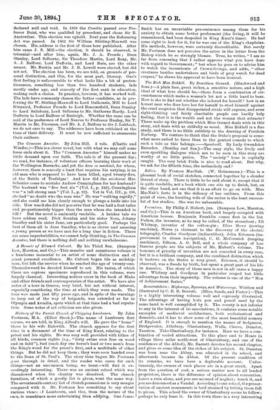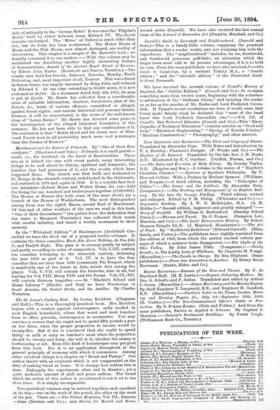Somersetshire : Highways, Byeways, and Waterways. Written and illustrated by
C. R. B. Barrett. (Bliss, Sands, and Foster.)—This is a highly interesting volume well and copiously illustrated. The advantage of having both pen and pencil used by the same hand is well exemplified by it. The county is not inferior to any in the interest of its associations, it contains some notable examples of mediaeval architecture, both ecclesiastical and domestic, and it has to show some of the most beautiful scenery of England. It is enough to mention the names of Sedgmoor, Bridgewater, Athelney, Glastonbury, Wells, Cleeve, Dunster, Taunton. Take Glastonbury, for instance. Here we have a com- bination of varied attractions. To this place and to Meare (a village three miles north-west of Glastonbury, and one of the residences of the Abbot), Mr. Barrett devotes his second chapter, and gives us some idea of the riches of his subject. St. Dunstan was born near the Abbey, was educated in its school, and afterwards became its Abbot. Of the present condition of its remains, we have here a deplorable account. Unfor- tunately, the owners of such places are in a great strait. Apart from the question of cost, a serious matter now to all landed proprietors, there is the difference of opinion about restoration. Leave a ruin alone, and you are accused of neglect ; touch it, and you are denounced as a Vandal. According to one school, the preser- vation of ancient monuments is befA attained by letting them fall to pieces. This school the owner of Glastonbury seems to follow; perhaps he only fears it. In this town there is a very interesting
relic of antiquity in the George Hotel.' It was once the Pilgrim's Hotel,' built by Abbot Selwood, temp. Edward IV. The facade remains unchanged. The `Mitre' at Oxford is much older than this, but its front has been modernised. The Manor House of Mears and the Fish House, now almost destroyed, are worthy of observation. This chapter is a sample of Mr. Barrett's work ; we
heartily commend it to our readers.—With this volume may be mentioned one describing another highly interesting feature of Somersetshire, Annals of the Ancient Royal Forest of Exmoor, by Edwin John .Rawle. (Barnicott and Pearce, Taunton.)—The county once held five forests, Selwood, Neroche, Mendip, North Petherton, and, most important of all, Exmoor. This was a forest in Saxon times, was largely increased by King John, and reduced by Edward I. At one time extending to 80,000 acres, it is now reckoned at 20,765. In a document dated July 4th, 1815, its area is put at 22,400. Mr. Rawle has collected here a considerable store of valuable information, charters, forest-laws, plan of the Forest, &e., trials of various offences, committed or alleged, against forest rights ; and various historical and personal details. Exmoor, it will be remembered, is the scene of the well-known story of "Lorna Doone." Mr. Rawle has devoted some pains to the investigation of the alleged historical foundation of this romance. He has not been able to find any confirmation of it. His conclusion is that " Robin Hood and his merry men of Sher. wood Forest were in all probability much more real personages than the Doones of Exmoor."



















































 Previous page
Previous page